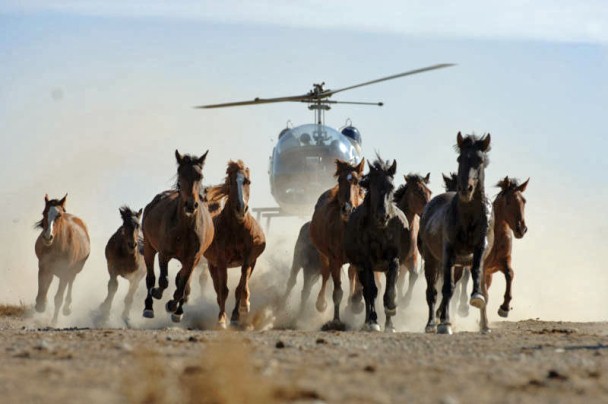Wild Horse Roundup Goes Awry
What to do with thousands of mustangs roaming the great American West

Thirteen wild horses were dead; hundreds more in shock and panic; all of them dehydrated and in urgent need of special care. This was not the way the government’s roundup of wild horses was supposed to go.
It was, nonetheless, what horse protection groups had feared in this vast hi-tech rodeo. Helicopters had been zooming down on them, sending the crazed mustangs careening in all directions, being herded back around, and eventually into corrals.
The horses, mostly mares and colts, had died either of dehydration or, ironically, from drinking too much water– a condition known as water intoxication – after being corralled.
Ginger Kathrens, executive director of the Cloud Foundation, a Colorado-based wild horse advocacy group, called the U.S. Bureau of Land Management’s actions “disgusting.”
The horses “were run over volcanic rock by helicopter for mile after mile,” she said. “We’re talking about the hottest time of the year. I’m not one bit surprised to hear that seven horses have died of dehydration. It’s what we’ve warned.”
The family life of horses
The Cloud Foundation is noted for Ginger Kathrens’ films about Cloud, a pale palomino, wild horse stallion living in the Pryor Mountains of Montana. Her films about him still air, from time to time, on PBS’s Nature series. One thing that emerges from watching these movies is the strong, complex family and social relationships of horses in the wild – very parallel to what we’ve learned about elephant herds, whale and dolphin pods, and the clans that are formed by chimpanzees, gorillas and humans.
When you go in and round up hundreds of horses, willy-nilly, you don’t just hurt and displace individual horses; you break up the entire social structure of their communities. You leave the young ones without the guidance and nurturing of their mothers and fathers, the wisdom of their grandparents, the whole fabric of their society.
In this video, from the Cloud Foundation, Howard Boggess, an Elder and historian of the Crow Tribe of Indians, talked about a planned roundup of Cloud’s herd in Spetember 2009. “The horses have lived here for over 200 years,” he says. “Even under the harassment of the BLM theyve survived since 1971.”
Of course, these wild herds didn’t just land there by themselves. We humans brought them to the West, and we are responsible for their welfare. When we abandoned them, they formed new herds of mustangs over generations, and became an integral part of the land — just like the buffalo herds.
What to do?
It is, admittedly, a difficult situation at best. There are no easy answers. Most conservation groups agree that hundreds more of the horses roaming the parched lands of Elko County, Nevada, could die of starvation and dehydration if left to themselves. But the roundup was, by any standards, inhumane. Nonetheless, a judge has ruled that it will continue.
“We have a major crisis here,” U.S. Bureau of Land Management spokesman Doran Sanchez. “And given the critical condition the animals are in, we could lose a lot of animals. Our main goal is to save as many animals as possible given the extreme emergency conditions.”
But horse protection groups have expressed outrage over the roundup, saying the deaths were predictable, given the hot summer temperatures and the weakened state of colts and mares that recently gave or were about to give birth.
The BLM has hauled more than 12,000 gallons of water to various sites in the roundup area, but the horses have not been drinking it and the agency doesn’t know why.
“We’ll try to do everything in our power to care for animals we save or humanely euthanize any animals that are down and suffering. We’ll do what’s necessary,” Sanchez said.
The 228 horses gathered last weekend were among up to 1,200 mustangs the agency intends to remove from the range in the area. The BLM plans to make them available for adoption or send them to long-term holding facilities in the Midwest.
BLM officials say the roundups are necessary because the mustang population is growing so rapidly that the animals are running out of food and harming the range and native wildlife. Skeptics say the agency is removing the mustangs to make room for livestock grazing and other interests.
BLM managers estimate that roughly 38,000 mustangs and burros roam 10 Western states, and half are in Nevada. The agency is in the process of removing about 12,000 animals to bring their numbers down to what it considers an appropriate management level.
~~~~~~~~~~~~~~~~~~~~~~~~~~~~
Organizations working to help America’s Wild Horses include:
In Defense of Animals, which advocates for the protection of wild horses
Madeleine Pickens Wild Horse Sanctuary
The Cloud Foundation
The Bureau of Land Management’s wild horse adoption program.
